How chatbot conversations vary around the world, and what that says about your customers
Customer support isn’t one-size-fits-all.
From Texas to Tokyo, people interact with chatbots in strikingly different ways. Some keep it short and sweet, others type essays. Some pepper messages with emojis, others are strict with punctuation. And many just want to talk to a human.
Recently, Sam Altman, OpenAI CEO, has admitted that people saying “thank you” and “please” are wasting millions of dollars in computer power.
But are we all that polite with artificial intelligence?
We analyzed millions of chatbot conversations across 100+ countries and all 50 US states, using data from Tidio’s Lyro AI agent, to uncover how people really talk to support bots.
Here’s what we found.
People talk to chatbots differently across the globe
Our global dataset reveals fascinating differences in how people communicate with AI support. Those can teach us more about cultural expectations, communication norms, and the evolving relationship between humans and technology.
From the tone of messages to the length of conversations, from emoji use all the way to escalation requests, it’s clear that chatbot interactions are far from universal. Just as people across cultures have different ways of saying “hello” or showing appreciation, they also approach digital customer service with distinct habits and expectations.
Read on to find out where your country stands.
Gratitude isn’t universal: who says thank you the most
The most polite countries? Ethiopia leads the world, with 7.5% of messages containing some form of gratitude. Trinidad and Tobago (6.8%) and Cameroon (6.39%) also top the list.
Top 5 most grateful countries
- Ethiopia (7.5%)
- Trinidad and Tobago (6.8%)
- Cameroon (6.39%)
- Nigeria (5.82%)
- Tanzania (5.38%)
The US is among the most grateful major economies at 3.99%, ranking just ahead of France (2.98%) and Germany (2.11%).
In the UK, 3.64% of messages include gratitude: a notch above the Western European average.
Cross-cultural psychology shows that expressing gratitude is deeply rooted in relationship norms and social structure. Collectivist cultures, especially in parts of Africa and Southeast Asia, treat gratitude as part of maintaining social harmony. That context likely contributes to African countries ranking high in our analysis. In contrast, individualistic cultures like those in Western Europe and North America commonly view gratitude as optional rather than obligatory.
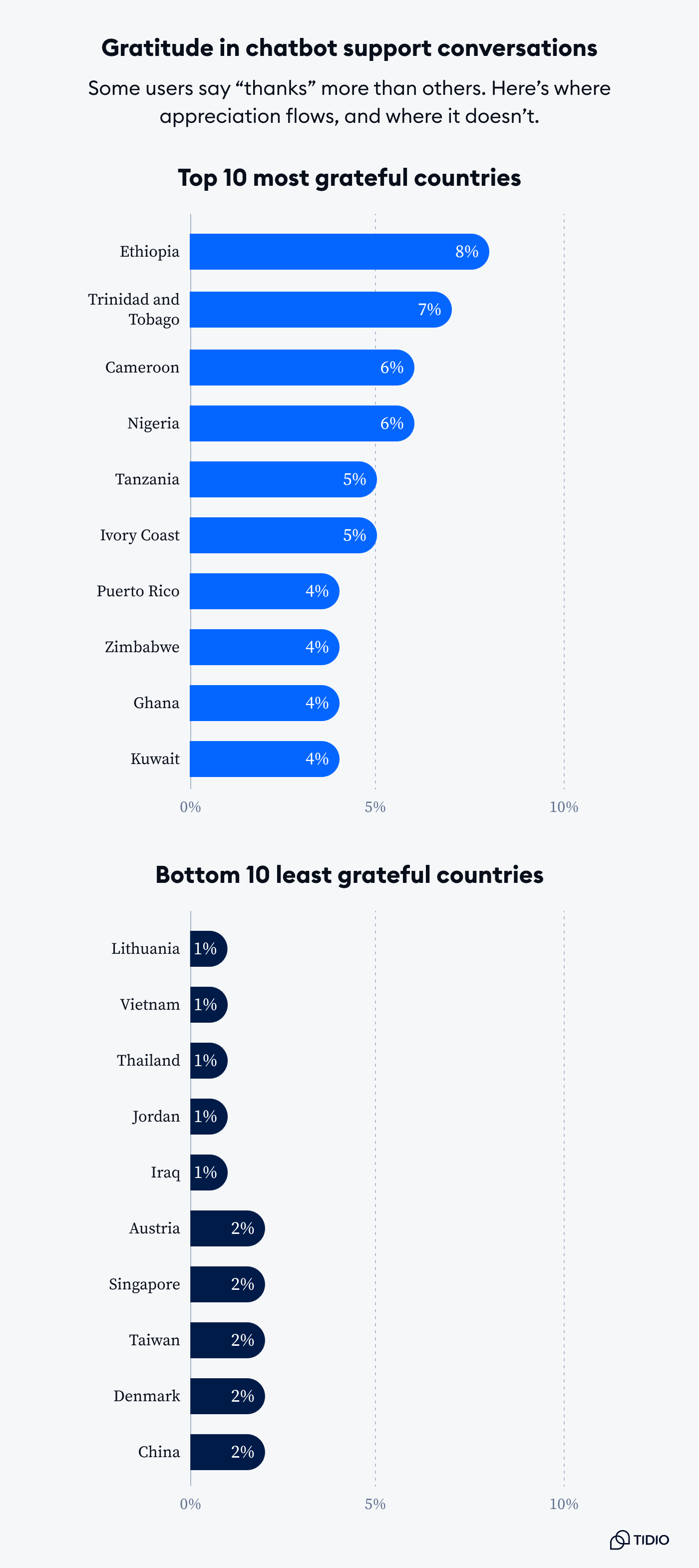
😊Emoji usage: not everyone speaks in symbols
Slovenia is an unexpected emoji fan, with 5.71% of messages containing emojis. Zimbabwe (3.90%) and Norway (2.08%) follow, though most countries fall well below the 2% mark.
The US average? Just 0.58%. The UK comes in at 0.86%, with most Western European nations staying under 1%.
Meanwhile, some countries barely use emojis at all: less than 0.5% in Austria, the Czech Republic, and Saudi Arabia.
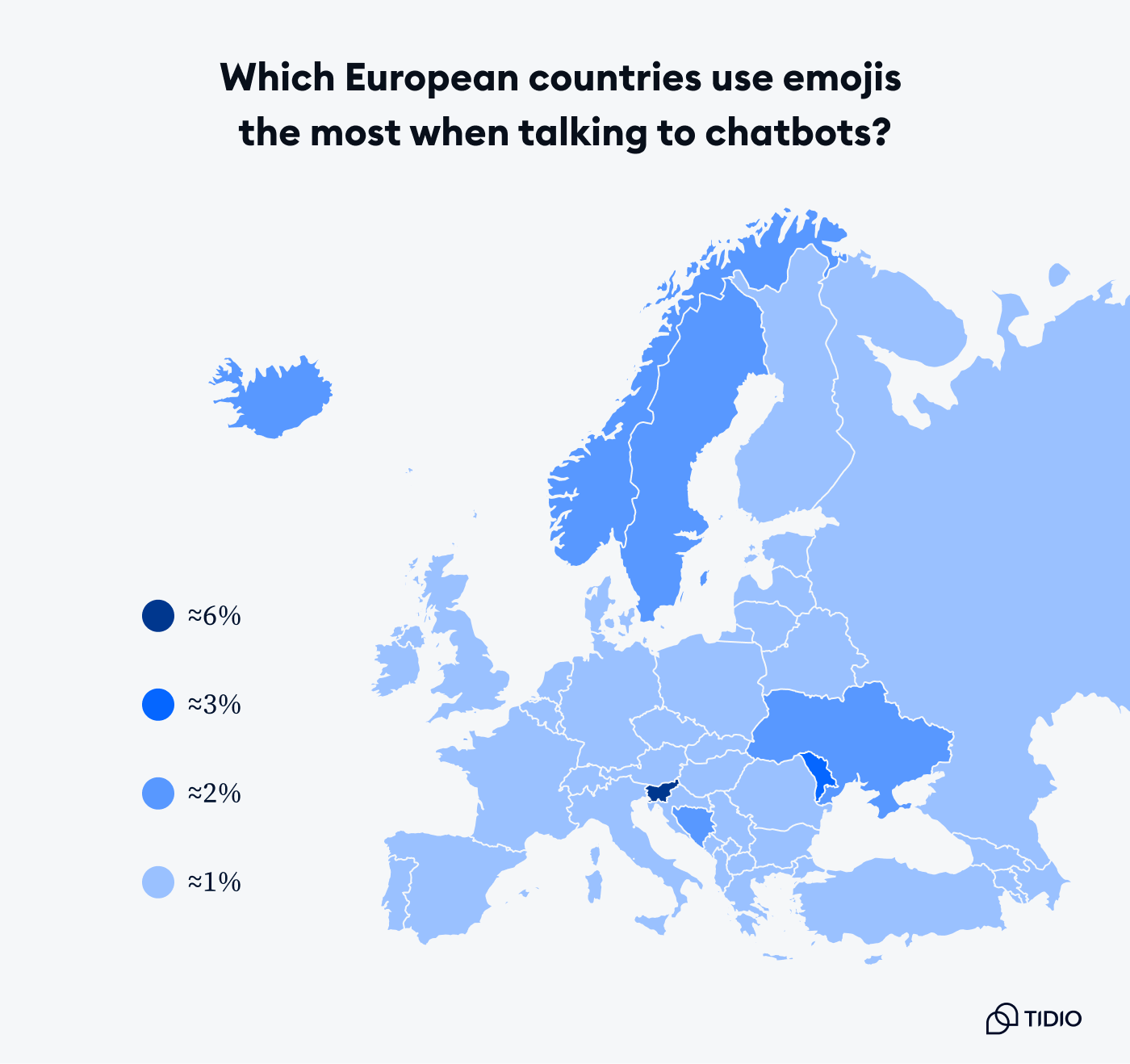
And what about chatbots including emojis in their messages?
A study found that emojis in chatbot interactions enhance perceived warmth, making conversations feel friendlier. This might be especially useful in markets where emoji usage dips below 1%.
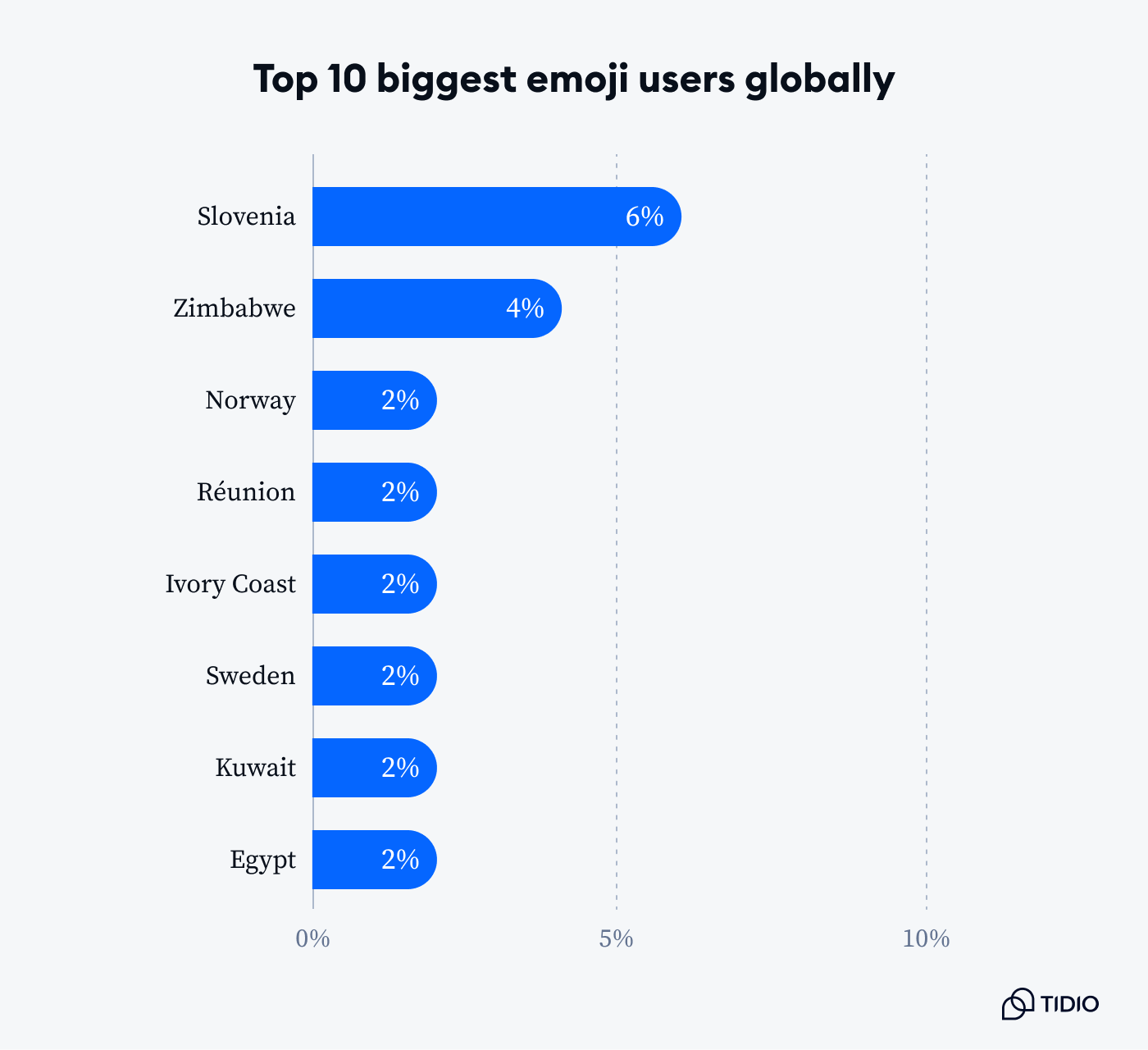
The United States: polite, wordy, and quick to escalate
Tidio’s US data, drawn from every state and territory, shows wide variation in user behavior.
Most polite states
Vermont (5.44%), South Dakota (5.15%), and Maryland (4.93%) top the list for gratitude. Midwestern and Northeastern states generally scored higher, reflecting a culture of customer service politeness. Even traditionally fast-paced states like New York show a respectable 4.05% rate of gratitude.
Surprise stat: Baker Island users express gratitude in 15.8% of interactions—far above any other state or territory. Perhaps because it’s uninhabited? Either way, it speaks highly of the US Fish and Wildlife Service employees who visit the island annually for conservation purposes.
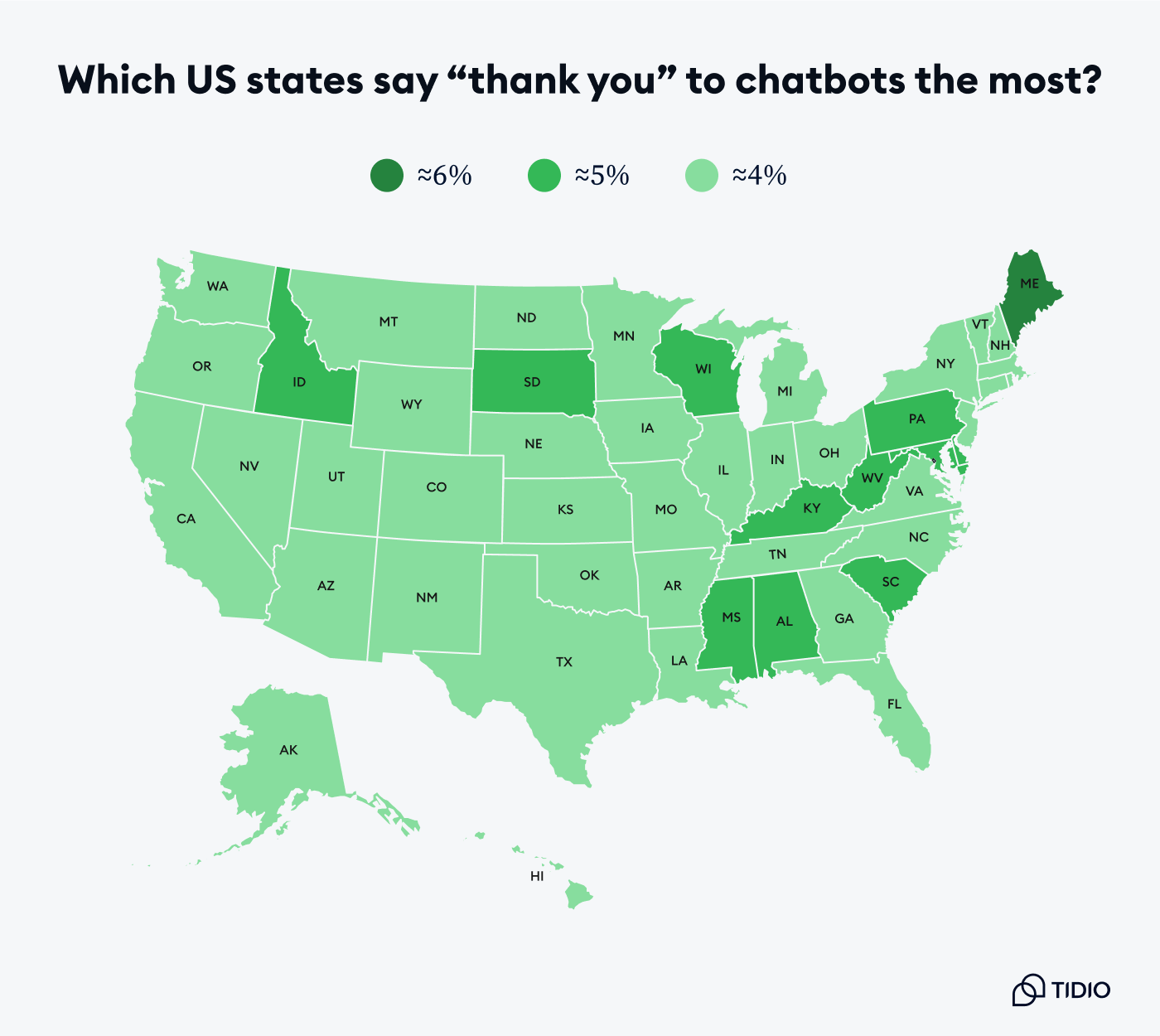
Escalation hot zones
Some states are quicker to demand “Let me talk to a human.” Vermont (9.34%), Utah (8.64%), and Mississippi (8.63%) lead the way in escalation requests. This could indicate lower tolerance for delays or a stronger expectation for human interaction.
The national average is around 8%, placing the US among the top-tier countries globally when it comes to human handoff.
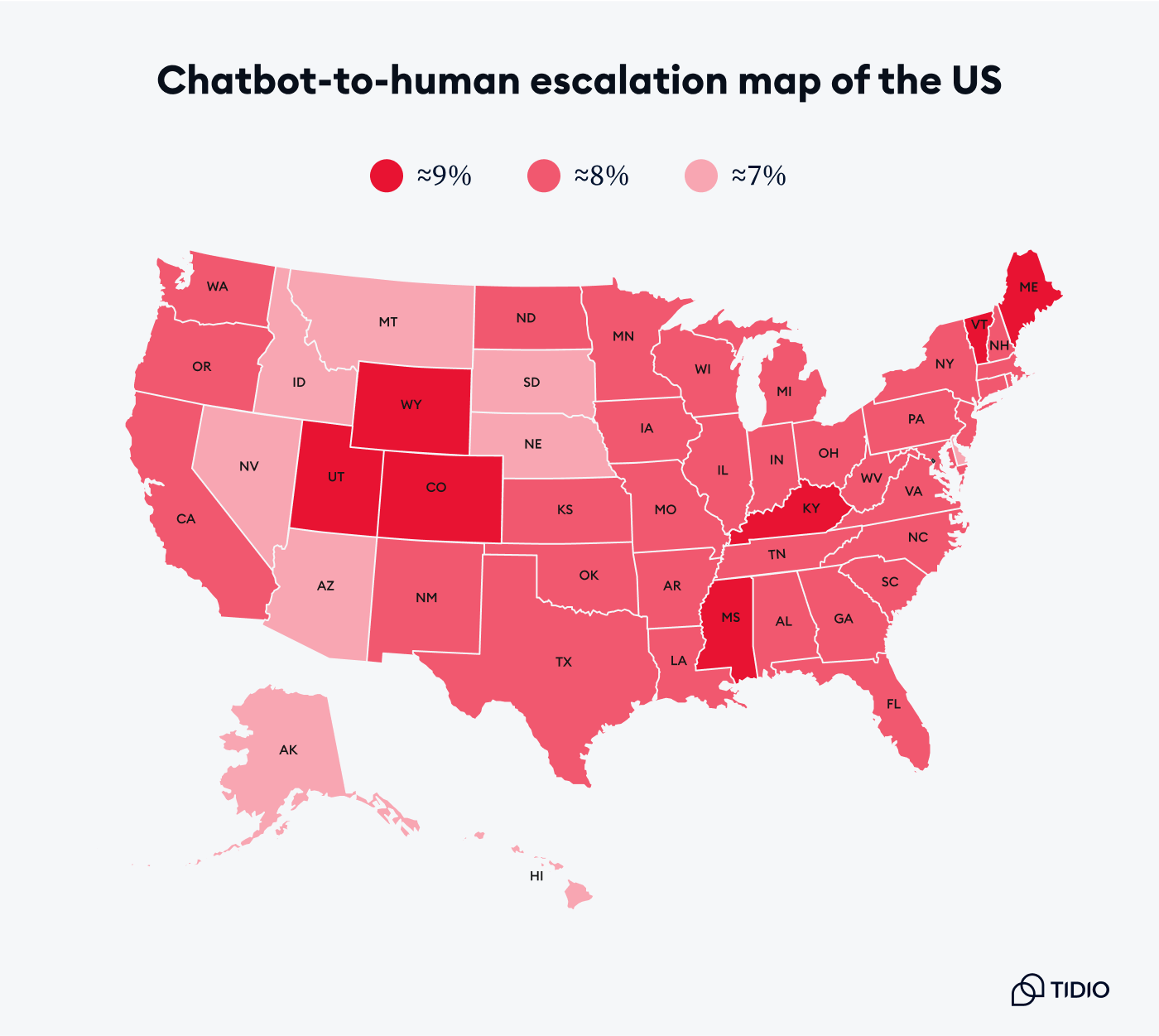
Who talks the most?
In message length, the US ranks 9th globally with an average of 54.36 characters per message. Montana, Maine, and Idaho residents lead the nation in chattiness.
Lyro AI’s resolution rate in the US sits at 66.04%, just behind countries like Germany and France.
The United Kingdom: concise and efficient
In contrast to their American cousins, UK users tend to get to the point.
- Average message length: 51.43 characters
- Median message length: 31
- Emoji usage: 0.86%
- Gratitude messages: 3.64%
- Escalation rate: 9.09%
That last metric places the UK in the global top 10 for transfers to human agents. While they may be brief, British users know when to escalate.
Still, Lyro AI performs well in the UK, resolving 64.7% of conversations without human assistance.
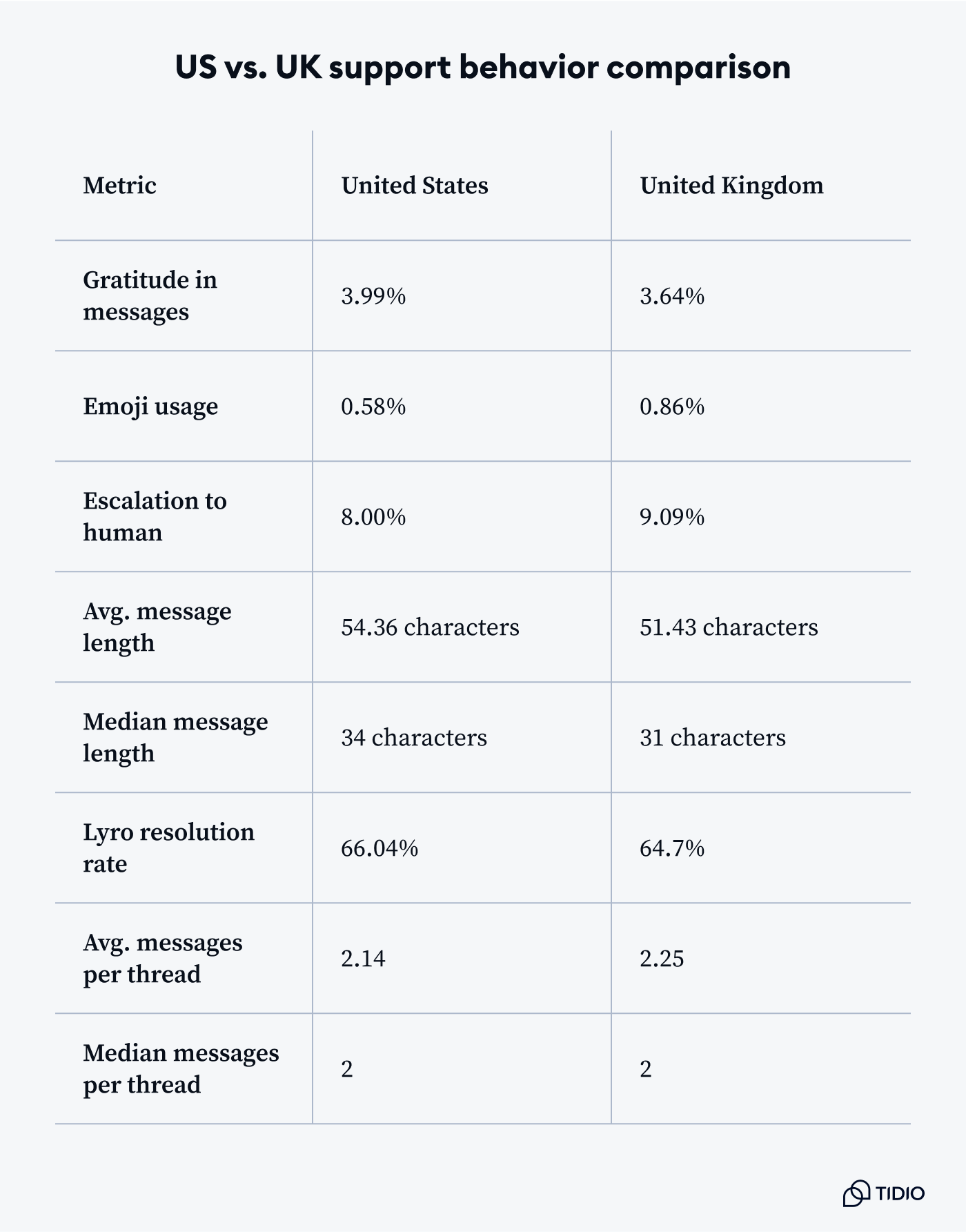
Escalation nation: where people want a human (and where they don’t)
Globally, the countries most likely to request a transfer to a human include:
- Cyprus (13.85%)
- Dominican Republic (12.61%)
- Sweden (10.65%)
- Romania (10.52%)
- Denmark (10.5%)
In contrast, Austria (2.34%) and Slovenia (2.75%) show strong satisfaction with AI-led support, likely due to their high Lyro resolution rates (82.93% and 73.68%, respectively).
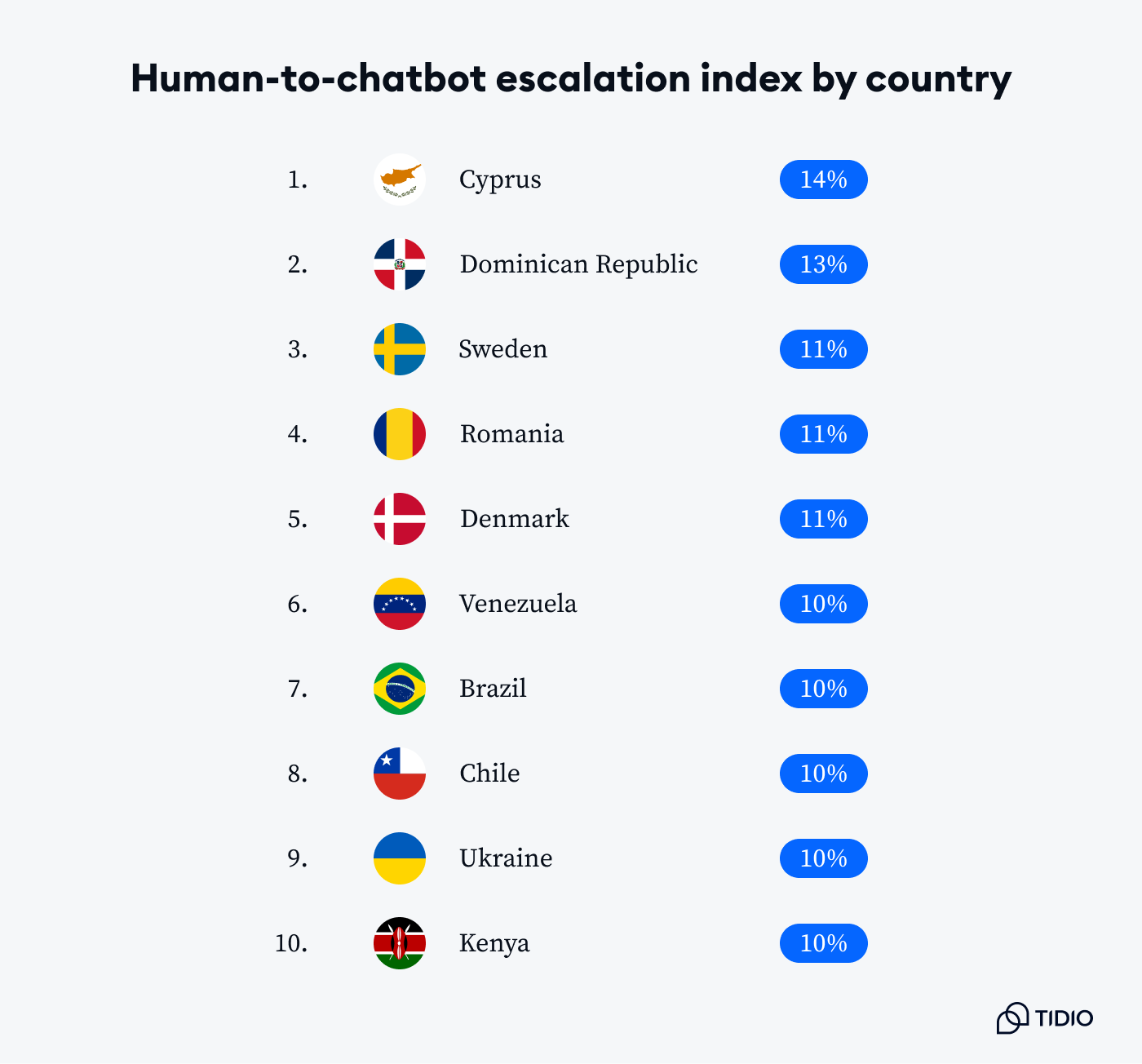
Who’s the chattiest? Message length reveals hidden trends
Average and median message lengths provide clues into how much people trust chatbots to understand context.
Top 5 countries by average message length:
- Cyprus: 80.86
- Italy: 66.9
- Austria: 66.5
- Pakistan: 65.3
- New Zealand: 64.5
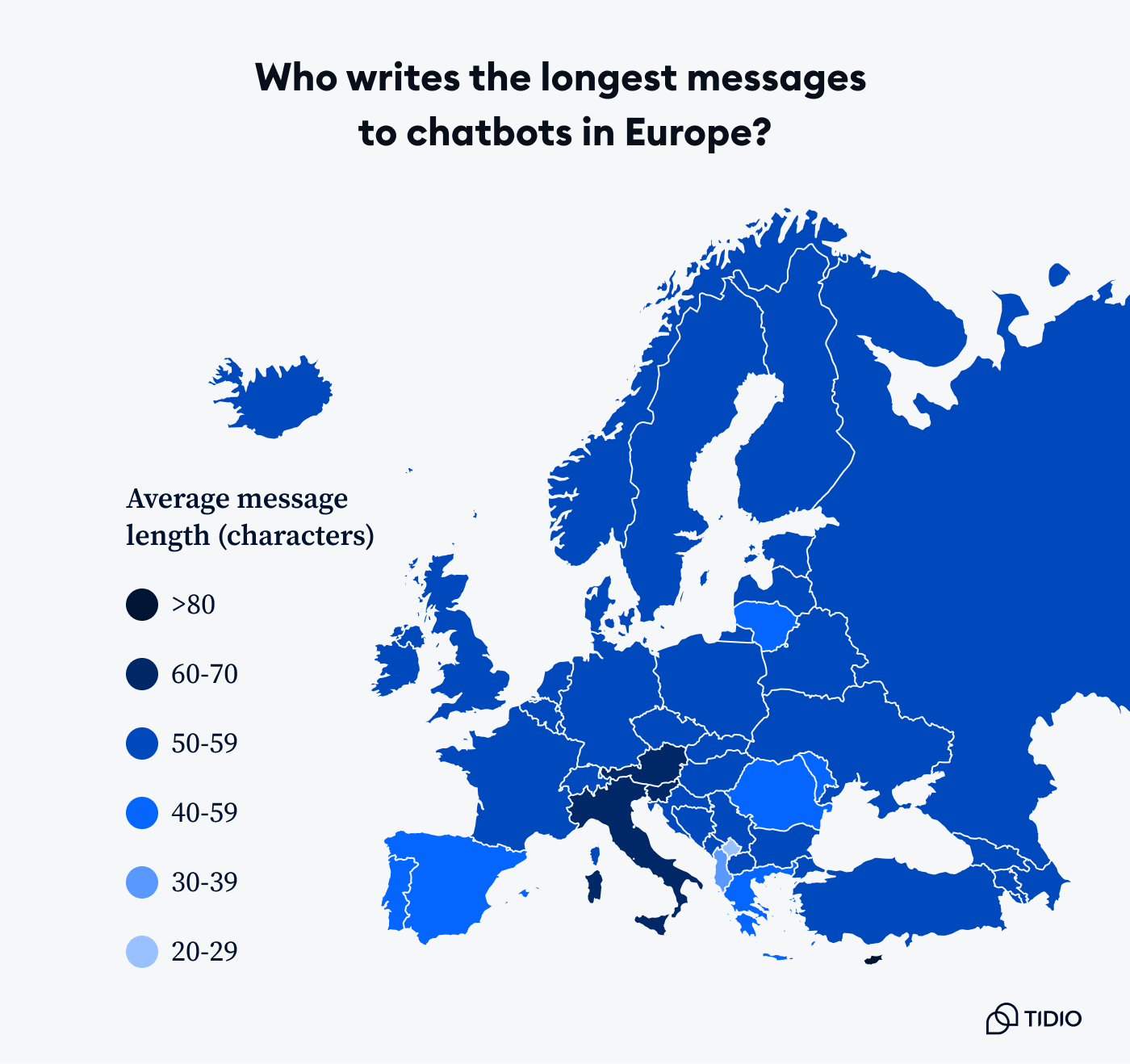
Shorter messages are more common in countries like Nepal (26.7) and Ethiopia (30.2). These might reflect more transactional use of bots or a preference for quicker replies.
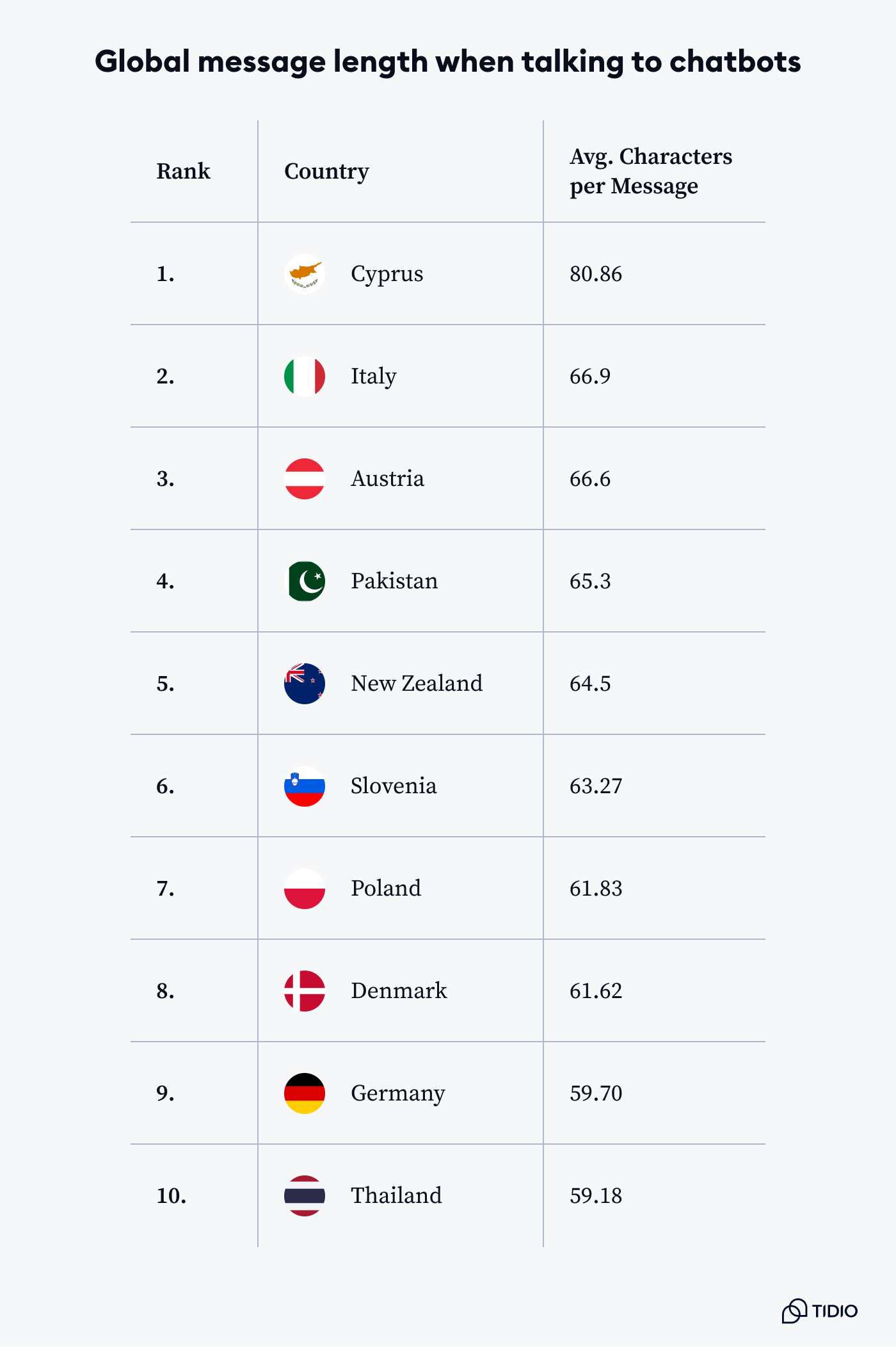
Cities that stand out
While national trends paint a broad picture, diving into individual cities reveals interesting local variations in how people engage with chatbots.
- Vienna (Austria) leads the global chart with a Lyro resolution rate of 83.42%. This could be a result of clear, information-rich queries. Users here send longer-than-average messages (66.7 characters), giving the AI more context to work with.
- Chicago (US) is both polite and proactive, with 4.03% of messages expressing gratitude, but also a high 8.59% escalation rate. This could reflect higher service expectations in large US metropolitan areas.
- Sydney (Australia) ranks among the most emoji-friendly cities, with 0.92% of messages including visual flair—double the global average.
- London (UK) mirrors national patterns with short messages (50.67 characters), high human handoff (9.84%), and a solid 63.95% resolution rate.
- New York (US) blends directness with politeness. Messages average 55 characters in length, and nearly 4% include a thank-you, showing how even in fast-paced cities, etiquette persists.
Bots vs. humans: how Lyro AI holds up globally
Lyro is Tidio’s conversational AI agent that helps businesses automate their customer support without sacrificing the human touch. Lyro learns from a company’s help center, FAQs, or product documentation in minutes and is designed to resolve up to 70% of support queries without needing escalation.
Lyro’s resolution rate (how often the AI fully resolves a customer query without escalation) is a strong indicator of chatbot performance. Rather than handing off conversations prematurely, Lyro is built to probe further, ask clarifying questions, and handle nuanced requests.
That may explain why countries with high resolution rates like Austria and Slovenia tend to have both longer messages and fewer handoffs. The more users trust the bot, the more context they’re willing to share.
Top 5 countries for resolution:
- Austria: 82.93%
- Croatia: 73.88%
- Slovenia: 73.68%
- Germany: 72.83%
- France: 71.62%
Key takeaways for support teams
Global customer support behavior often reflects cultural norms and communication styles. In gratitude-heavy regions like Ethiopia and Trinidad and Tobago, politeness and formal courtesy are deeply valued and expressed, even in digital interactions. This appreciation for assistance likely boosts overall chatbot satisfaction, even when conversations are brief.
On the other hand, longer messages in countries like Cyprus and Italy may reflect a cultural preference for context, detail, and clarity. In these regions, customers may feel more comfortable explaining their issues fully, trusting that their message will be understood and acted upon.
Low emoji usage in countries like Germany and Japan isn’t necessarily a lack of friendliness. It may stem from a cultural emphasis on professionalism and efficiency. Conversely, Slovenia’s high emoji use could reflect a more expressive communication style, where tone and emotion are part of even practical exchanges.
The UK’s high escalation rate, paired with concise messaging, might hint at a customer base that values fast, human interaction when resolution isn’t immediate. This is consistent with a service-savvy culture that expects results without delay.
Understanding these cultural patterns helps support teams go beyond generic chatbot flows. Tidio’s Lyro AI agent can be adapted to respect regional expectations.
- No two regions interact with bots in the same way. The US and UK alone show dramatic variation in escalation rates, gratitude, and emoji use.
- High message lengths and low emoji use often correlate with higher bot resolution rates.
- Countries like Austria and Germany show that well-trained AI like Lyro can resolve 70%+ of queries without human help.
- In contrast, regions with high transfer-to-human rates may benefit from better chatbot onboarding, training, or escalation logic.
For support teams looking to scale smartly, tailoring your chatbot experience by region is a must. And with adaptable AI like Lyro, you’re already halfway there.
Methodology
This report is based on internal data collected by Tidio from chatbot conversations powered by our platform, including Lyro AI. We analyzed millions of anonymized interactions from users across more than 100 countries and every US state. To ensure fair representation and avoid skewed results, only countries with more than 1,000 monthly conversations were included in the analysis. All findings reflect genuine usage patterns and customer behavior observed directly through our platform.
Sources
- Sam Altman Admits That Saying “Please” and “Thank You” to ChatGPT Is Wasting Millions of Dollars in Computing Power
- Emojifying chatbot interactions: An exploration of emoji utilization in human-chatbot communications
- Universals and cultural diversity in the expression of gratitude
- Tidio’s AI Agent Lyro Achieves Industry-Leading Customer Support Resolution Rates, Outperforming Intercom
- Baker Island National Wildlife Refuge

